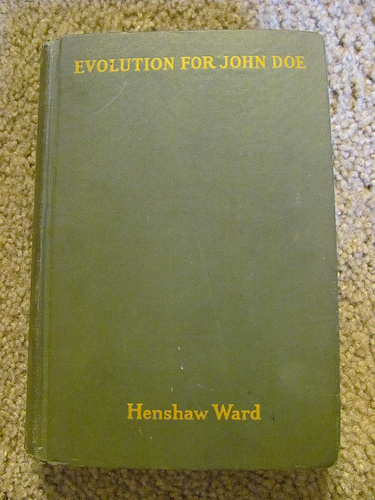
In part 1, I introduced Henshaw Ward’s Evolution for John Doe (1925). Ward, a teacher of English turned science popularizer, claimed that for twenty years he sought a popular treatment of evolution to recommend to the curious, but without success. “Apparently biologists know so much of the details that they can not [sic] write a brief account of the whole theory.” Eventually, “I grew so desperate as to read a number of the standard works of evolution,” and his book attempts to present a digest of them, “as if I were telling a friend about the knowledge that is so new and imperfect in my mind.” The book was praised at the time—the New York Times Book Review described the book as “an interestingly sketchy and delightful ‘talk’ on evolution, written in a popular manner for John Doe, and as such is a real achievement”—but I’m interested in it on account of the first chapter, which not only lists what Ward takes to be misconceptions about evolution but also explains how the book attempts to defuse them. I want to work through Ward’s list in order.
The first misconception: “John Doe thinks that evolution is ‘the doctrine that man is descended from monkeys.’” There are at least three submisconceptions (as it were) here: that evolution is distinctively concerned with human ancestry, that humans are descended from modern primates, and that human descent from non-human ancestry is intrinsically ridiculous or offensive. Not pausing to unpack the misconception, Ward announces that “any one who tries to explain evolution to [John Doe] will fail if he pays the least attention to the ‘monkey doctrine,’” and accordingly ignores human evolution throughout the book. Reviewing Evolution for John Doe for The Saturday Review of Literature, Vernon Kellogg—the Stanford entomologist and the author of, inter alia, Headquarters Nights (1917)—deplored the omission; although he concluded his review by recommending the book “warmly to anyone wanting an informing and readable book about evolution,” he added, “But I wish the author had put man into his book! I did in mine!” (Presumably he had in mind his own Evolution: The Way of Man [1924].)
Ward’s decision to exclude human evolution from his book altogether was extreme by the standards of contemporary science popularization, according to Constance Areson Clark’s God—or Gorilla (2008). But “other authors also deemphasized human evolution” in the 1920s, mindful both of the potential of the topic to be counterproductively distracting and of the then comparatively underexplored fossil record of human descent. Remember, the Taung baby—the first specimen of Australopithecus africanus—wasn’t discovered by Raymond Dart until 1924, and it took years before Dart’s assessment of its significance for human evolution was accepted by the paleoanthropological community. I haven’t checked, but I expect that, since the 1920s, coverage of human evolution in popular expositions increased as the scientific understanding of the human lineage increased. Certainly popular works on evolution today—such as Alan R. Rogers’s The Evidence for Evolution (2011), chapter eight of which asks “Did Humans Evolve?” (spoiler: yes)—include human evolution without any fuss.
The second misconception: “John Doe thinks that evolution explains the origin of life.” Here, too, Ward decides to omit the topic. His reason isn’t, as it was for human evolution, the worry that a discussion would be counterproductively distracting. I wonder, though. As I noted a while ago, in 1927, the creationist author Byron C. Nelson was complaining of “inconsistent” evolutionists who suppose that God miraculously created the first living organism but then allowed the natural processes that drive evolution to take their course thereafter without further divine intervention. Nelson replied, “if it be granted that God made the first cell, it cannot well be denied that he may and could and very likely did create other species by distinct creative acts, as the Bible sets forth.” Insofar as the “inconsistent” position on evolution was popular among the general public in the 1920s—and my impression is that it was, and still is—a possible consequence is that addressing the origin of life while discussing evolution is to open the door, counterproductively, to Nelson’s line of argument.
Yet that isn’t Ward’s stated reason for not discussing the origin of life. Instead, he cites the paucity of scientific knowledge. Certainly at the time that he was writing, that was a reasonable consideration. A. I. Oparin’s seminal work on the origin of life was just starting to be published, in Russian, and Stanley Miller’s experiments were twenty-eight years in the future. As with human evolution, scientific understanding of the origin of life is greatly advanced since the 1920s (see a nice suite of articles from 2012 in Evolution: Education and Outreach). In Why Evolution is True (2009), Jerry Coyne nevertheless scants the topic, writing, as Ward might have written, “Because this field is in its infancy, and has yet given few answers, I’ve omitted from this book any discussion of how life on earth began.” But Richard Dawkins is more optimistic in The Greatest Show on Earth (2009), judging it “quite likely that chemists will, within the next few decades, simulate in the laboratory a full reconstruction of the events that launched natural selection on its momentous way four billion years ago.” To be continued in part 3.

